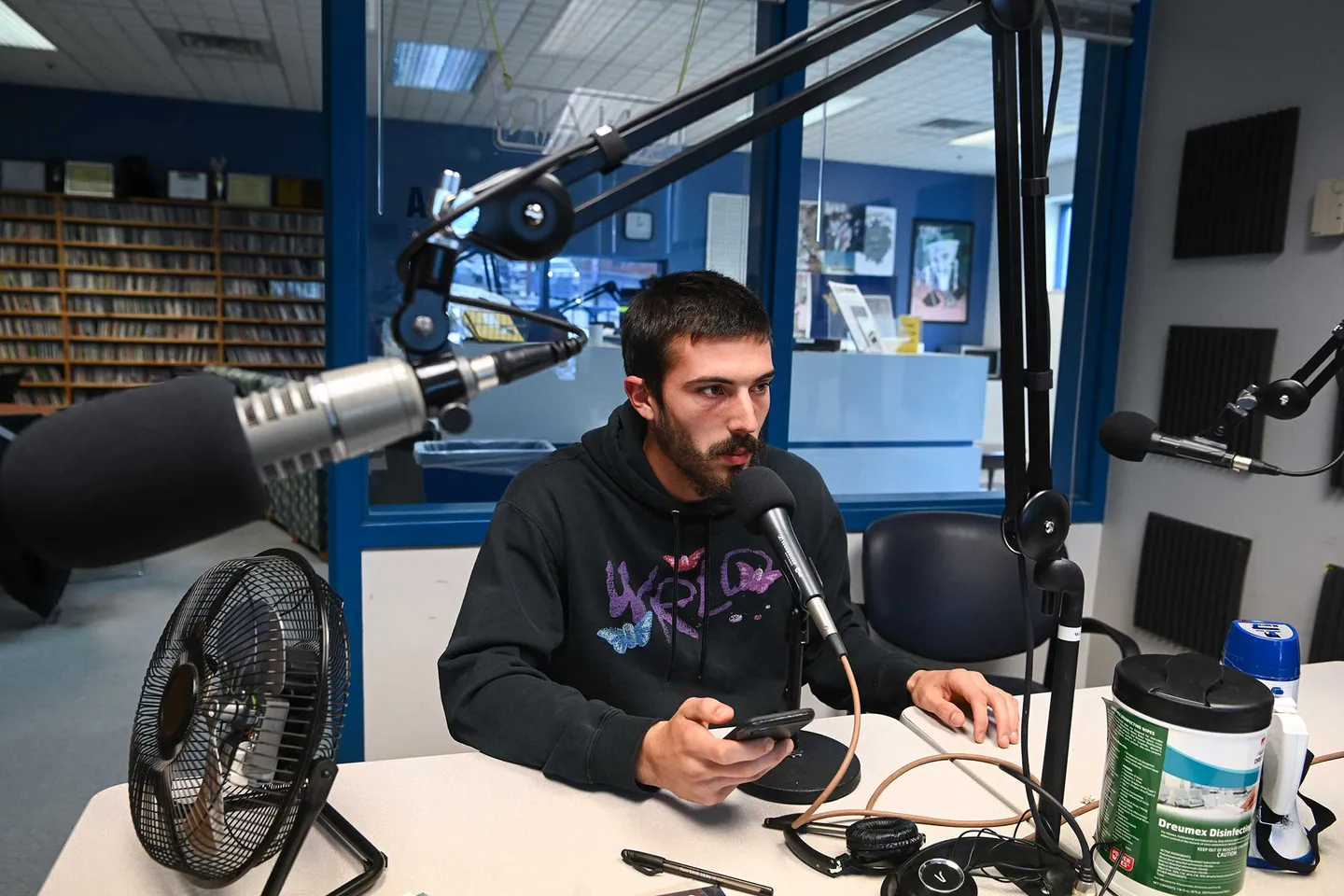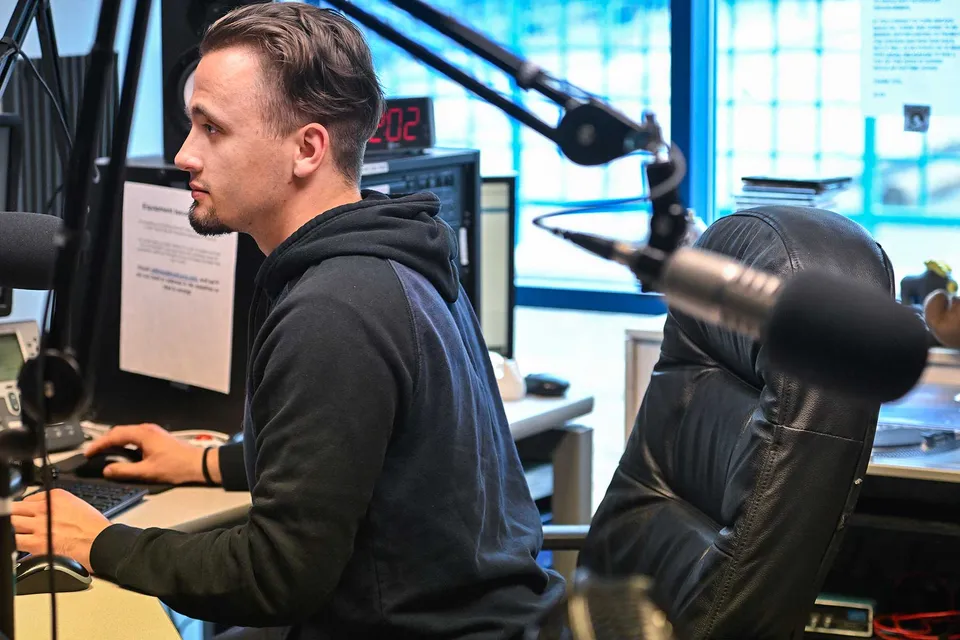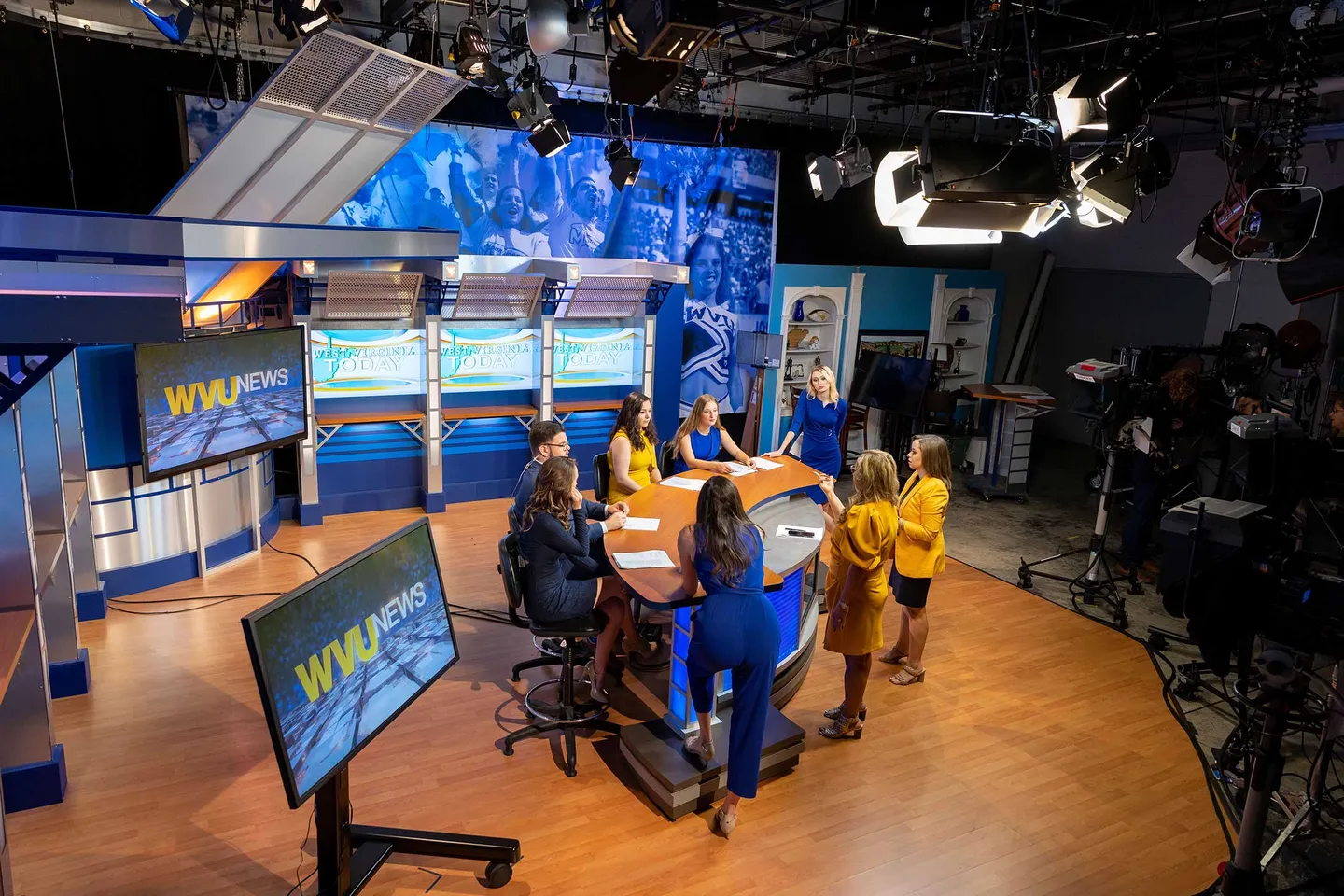Students like Makenna Leisifer, Tolu Olasoji and Lara Bonatesta are among the star
performers this year and each already had several job offers on the table at the
end of their senior year. These students are part of the intensely hardworking
crew of WVU News, an Emmy-award-winning student-produced TV newscast that has swept
up more than 150 awards over the past decade and churned out hundreds of successful
grads for years. WVU News was designed as a capstone class for journalism students
who want to enter broadcast television production, offering hands-on experience
producing and reporting news for several outlets including a top 25 TV market-KDKA-TV
in Pittsburgh, a statewide broadcast network-West Virginia Public Broadcasting
(WVPB), HD Media, which is the publisher of seven statewide newspapers and the
City of Morgantown’s Public Access Channel.
Leisifer, as the outgoing producer of WVU News, describes herself as a leader among
her fellow students. “I’m the one that puts our show together. I’m the one that
takes everybody’s packages and creates the big piece you see on our YouTube channel
and media website for the college,” she said. In a nutshell, whenever the student
news anchors and reporters step in front of the camera, she’s behind the scenes,
a voice in their ear, encouraging, offering constructive feedback and keeping everyone
on time. She and her co-producer Olsaoji are also writers, stacking stories into
a narrative that flows on camera, checking pronunciation, creating teasers, intros
and outros and helping reporters and anchors flesh out stories and improve their
narratives. “If anything gets messed up, the credibility is on both of us,” Leisifer
said. “So, we take our positions super, super seriously.”
Olasoji’s official title is associate producer, but he’s also the class videographer
and technical director. He frequently field produces, working with reporters roving
across the state and locally to gather stories. He even picks up the helm from
Leisifer if she’s out of commission (like when she came down with COVID last year).
He loves wearing different hats, despite the innate challenges of constantly switching
roles. “I have to be tuned in, 101-percent,” he said. “As much as what's being
said is vital, what you see on your screen is also vital. You can’t waste time.
You have to pull in the right graphics and all of that.”
Bonatesta, culture editor at the
Daily Athenaeum and the data/visualization reporter/anchor for WVU News, never
planned on being in front of the camera, but it was a natural fit with her skills.
“I just like to tell stories. And so that's why the reporting side of it is just
so special to me,” she said. “This semester, what I do is very data heavy. I’m
doing a lot of research for every story, going into these complex topics like insulin
pricing. You can’t go out there not knowing what you’re talking about. You think
that person is just there to smile at the camera, but there’s so much more that
goes into it — the writing, researching, interviewing. It really has been awesome.”
The course was designed to be hands-off, mimicking the way a real broadcast newsroom
would run. If a reporter needs help with anything, from directions to finding a
statistic to securing an interview, it isn’t Dahlia or Marra the students come
to; they turn to their student leaders. “Everything is done completely by students
in the field and on show day,” Dahlia said.
And the students aren’t simply producing homework or fulfilling tasks, they have
a real impact on the communities they report in. “We don’t limit ourselves to just
campus,” Olasoji said. In fact, with an average class size of 15-to-20, they only
assign one campus reporter to cover University topics. The rest of the cohort runs
the gamut from health to crime to recreation to entertainment. They’ve reported
on drug addiction and recovery; the campus carry bill; stem cell research; healthcare
in the LGBTQ community; air and water contamination after the Ohio train derailment
and more — just in 2023. “They are learning what they are going to be learning
in the real world,” Dahlia said. “The biggest sign of success is that every one
of these students have job offers on the table and they've not even graduated yet.
What more could you want as a student?”
Alums of the WVU News program, as well as Mountaineer Playbook, earn positions in
major TV markets across the state and the country every year. “Every news director
in the state comes to us because our students know what they’re doing. They want
our grads to start working for them. We currently have students not only working
in local TV stations, but also at outlets such as Good Morning America, CNN, Radio
Disney, ESPN and Scripps Howard, to name a few.”
Fearless journalism
There is perhaps no better measure of the success of an educational program, whether
college-bound or completey independent, than the way alums talk about their experiences.
Ken Ward, Jr.,’90, journalism, is just one example.
Ward is an investigative reporter, distinguished fellow in ProPublica’s Local Reporting
Network, former environmental and investigative reporter at
The Charleston Gazette and
Gazette-Mail, co-founder of
Mountain State Spotlight (a statewide nonprofit civic news organization), winner
of numerous awards — a MacArthur “genius grant,” the Scripps Howard Foundation’s
Edward J. Meeman Award for Environmental Reporting (three times), the Livingston
Award for Young Journalists (and many others). But he proudly says he got his start
right here in Morgantown, reporting for the DA. Like many journalists, he stumbled
into reporting and quickly felt the call.
“I was just walking around, getting a feel for campus. I was interested in finding
out about the DA, and I stumbled past what was then the DA home. Everyone there
— the editors, the reporters, sports writers — seemed to be really having a good
time,” he said. “I connected with that, started doing some stories, found out,
in fact, they
were having a really good time. And I did, too.”
Some of Ward’s early stories, investigations into student fee increases at WVU and
into connections between the construction of a Morgantown power plant and WVU donors,
fueled his lifelong love affair with investigative journalism.
“There was a lot of feeling among people on campus and around the Morgantown community
who were concerned, who felt that those concerns weren't being aired in the commercial
media locally. So, we did it,” he said. “I think I revealed some things that students
didn't know about, that the administration of the University would've preferred
they not know about. I discovered that was very fulfilling and fun. And it seemed
to be something I was good at — something that could help make the world better.”
Ward moved up from reporter to news editor to managing editor of the DA, which was
the top role at the time, over the course of his college career. He also made connections
between what he learned in class (such as when professors brought in local journalists
to talk about their careers) and his very real job at the student newspaper. He
learned “there are a lot of ways to commit acts of journalism, and different things
drive different people. For me, journalism was a way to try to temper the power
of those who would abuse their power to enrich themselves or harm others.” These
experiences shaped how he felt about his future.
As for the future of journalism, Ward believes, while the technology is rapidly advancing
(he recalls not even having access to a fax machine during his tenure at the DA),
the call and the need for student-run media remains.
“For me, the purpose of student-run media, independent media, on university campuses
is not just to help students learn how to do journalism, but to hold powerful institutions
on campus accountable for what they're doing or not doing,” Ward adds.
Journalists and media professionals just stepping into the work force today are facing
a future full of both challenge and opportunity. And student-run media at WVU,
both independent and college-tied, is working to keep pace, churning out alums
at the forefront of their fields. Grads like Duncan Slade, ’22, journalism, are
poised for impactful careers thriving equally in the chaos of a newsroom and the
uncharted territory of the digital sphere.
Slade’s experience in the world of journalism is multifaceted, as any media professional’s
must be in the current era. He started in photojournalism in 2017, freelancing
for local papers and studios in Frederick, Md. After transferring to WVU from his
community college in 2019, he moved into the digital realm, producing video for
social media as a WVU intern. He started at the DA in the same year, working first
as a staff photographer, then photo editor and news writer, taking over as editor-in-chief
in 2021. While at the helm, he helped to modernize the paper, more than doubling
the publication’s readership through analytics, audience engagement and a digital-first
newsroom restructuring.
On the side, Slade also worked as a reporter at West Virginia Public Broadcasting,
an intern at
Mountain State Spotlight and a reporter at
Politifact. He said his proudest moment was seeing his byline on the front
page of
The Washington Post. Today, he’s deputy managing editor at
Mountain State Spotlight.
“The thing I feel like you have to have most as a journalist is just a curiosity
about the world,” Slade said. “Later in your career, you might drill down into
a particular beat or particular thing. But you have to be interested in the world,
you have to be interested in life, you have to be interested in people. Journalism
is a tough industry. It can be really challenging. But it is a very rewarding industry.
You get to meet a lot of different people.”
One of Slade’s most important roles right now, he believes, is helping to transform
the face of journalism and media, how it responds to and reflects the needs of
the audiences and communities whose voices often go unheard. Beyond even the technology
chops, the digital reels and the investigative skills, that desire and ability
to transform media from the ground up is what his college-age experience has really
prepared him for (both at WVU and as an independent journalist).
“A big part of our mission is getting outside those big cities and talking with a
lot of different people in the state and asking them, ‘What news do you need and
what type of stories can we tell that would be helpful to you?’ I think that's
something journalists in the last 10-to-15 years have been doing more of, just
getting out and talking to people. Because to be frank, the research numbers for
trust in the media are not very high,” he said. “But when people talk to a journalist
who comes to their town without a specific story in mind, not just when something
terrible happens, I think that can go a long way toward rebuilding that trust.”
Career Moves
Makenna Leisifer accepted a job as a producer at WSAZ-TV NewsChannel 3 in Charleston/Huntington, W.Va.,
immediately after graduation. The station is a number 70 TV market out of 210
TV markets in the U.S.
Lara Bonatesta accepted a job as a digital content producer at WHTM-TV ABC27,
a in Harrisburg, Pa., immediately after graduation. It is a number 43 TV market
out of 210 TV markets in America.
Many of WVU’s media-engaged students are part of the WVU Reed College of Media.
Check out a list of their recent awards and accolades
.







